- Clone
- 108A2 (See other available formats)
- Regulatory Status
- RUO
- Other Names
- Lgals9, Gal-9, Ecalectin
- Isotype
- Rat IgG2a, κ

-

C57BL/6 mouse frozen thymus section was fixed with 4% paraformaldehyde (PFA) for ten minutes at room temperature and blocked with 5% FBS for 30 minutes at room temperature. Then the section was stained with 10 µg/mL of anti-mouse Galectin-9 (clone 108A2) Alexa Fluor® 647 (red) and CD90.2 (clone 30-H12) Alexa Fluor® 488 (green) overnight at 4°C. The image was captured with a 10X objective.
| Cat # | Size | Price | Quantity Check Availability | ||
|---|---|---|---|---|---|
| 137909 | 25 µg | $159.00 | |||
| 137910 | 100 µg | $370.00 | |||
Galectin-9 is a mammalian lectin with a molecular weight of 40 kD that has two conserved carbohydrate recognition domains (CRDs) and forms homodimers. It recognizes N-acetyllactosamine (Galbeta1-4GlcNAc) and T-antigen (Galbeta1-3GalNAc); Tim-3 has been reported as its ligand. Galectin-9 is expressed by lymphocytes, dendritic cells, granulocytes, eosinophils, astrocytes, endothelial cells, fibroblasts and thymus epithelial cells. It may be retained intracellularly or be transported to the cell surface where it is cleaved, thereby generating a soluble form. Galectin-9 is involved in events such as cell aggregation, cell adhesion, chemotaxis and apoptosis. Importantly for the regulation of the immune response, Galectin-9 induces regulatory T cells and suppresses Th1 and Th17 responses.
Product Details
- Verified Reactivity
- Mouse
- Antibody Type
- Monoclonal
- Host Species
- Rat
- Immunogen
- Full length recombinant mouse Galectin-9 (M-type)
- Formulation
- Phosphate-buffered solution, pH 7.2, containing 0.09% sodium azide.
- Preparation
- The antibody was purified by affinity chromatography and conjugated with Alexa Fluor® 647 under optimal conditions.
- Concentration
- 0.5 mg/ml
- Storage & Handling
- The antibody solution should be stored undiluted between 2°C and 8°C, and protected from prolonged exposure to light. Do not freeze.
- Application
-
IHC-F - Quality tested
- Recommended Usage
-
Each lot of this antibody is quality control tested by immunohistochemical staining on frozen tissue sections. For immunohistochemistry, a concentration range of 5 - 10 µg/ml is suggested. It is recommended that the reagent be titrated for optimal performance for each application.
Alexa Fluor® and Pacific Blue™ are trademarks of Life Technologies Corporation.
View full statement regarding label licenses - Excitation Laser
-
Red Laser (633 nm)
- Application Notes
-
Clone 108A2 recognizes the linker peptide of mouse Galectin-9; it does not cross-react with stable Galectin-9 (which is biologically active, genetically engineered, linker-less Galectin-9)3. Additional reported applications (for the relevant formats) include: sandwich ELISA as capture antibody1 and immunohistochemical staining of paraffin2 embedded tissue sections.
-
Application References
(PubMed link indicates BioLegend citation) - RRID
-
AB_2810406 (BioLegend Cat. No. 137909)
AB_2810407 (BioLegend Cat. No. 137910)
Antigen Details
- Structure
- Homodimer, each chain is a 343 aa protein of 40 kD that has two conserved carbohydrate recognition domains (CRDs)
- Distribution
-
Lymphocytes, dendritic cells, neutrophils, eosinophils, astrocytes, endothelial cells, fibroblasts, thymus stromal/epithelial cells
- Function
- Cell aggregation, cell adhesion, chemotaxis, apoptosis, suppression of Th1 and Th17 responses, induction of regulatory T cells
- Ligand/Receptor
- Tim-3
- Cell Type
- Astrocytes, Dendritic cells, Endothelial cells, Eosinophils, Epithelial cells, Fibroblasts, Lymphocytes, Neutrophils, Tregs
- Biology Area
- Apoptosis/Tumor Suppressors/Cell Death, Cell Adhesion, Cell Biology, Cell Motility/Cytoskeleton/Structure, Immunology
- Molecular Family
- Adhesion Molecules, Immune Checkpoint Receptors
- Antigen References
-
1. Klibi J, et al. 2009. Blood 113:1957.
2. Seki M, et al. 2008. Clin. Immunol. 127:78.
3. Tsuboi Y, et al. 2007. Clin. Immunol. 124:221.
4. Zhu C, et al. 2005. Nat. Immunol. 6:1245.
5. Dunphy JL, et al. 2002. J. Biol. Chem. 277:14916. - Gene ID
- 16859 View all products for this Gene ID
- UniProt
- View information about Galectin-9 on UniProt.org
Other Formats
View All Galectin-9 Reagents Request Custom Conjugation| Description | Clone | Applications |
|---|---|---|
| Purified anti-mouse Galectin-9 | 108A2 | FC,ICFC,IHC-F,WB,ELISA |
| PE anti-mouse Galectin-9 | 108A2 | FC |
| Alexa Fluor® 594 anti-mouse Galectin-9 | 108A2 | IHC-F |
| Alexa Fluor® 488 anti-mouse Galectin-9 | 108A2 | IHC-F,IHC-P |
| PE/Cyanine7 anti-mouse Galectin-9 | 108A2 | FC |
| APC anti-mouse Galectin-9 | 108A2 | FC |
| Alexa Fluor® 647 anti-mouse Galectin-9 | 108A2 | IHC-F |
Compare Data Across All Formats
This data display is provided for general comparisons between formats.
Your actual data may vary due to variations in samples, target cells, instruments and their settings, staining conditions, and other factors.
If you need assistance with selecting the best format contact our expert technical support team.
-
Purified anti-mouse Galectin-9
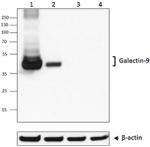
Western blot analysis of mouse thymus (lane 1), MEF (lane 2)... 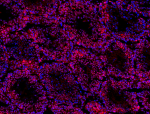
C57BL/6 mouse frozen testis section was fixed with 4% parafo... -
PE anti-mouse Galectin-9
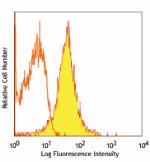
C57BL/6 thymocytes stained with 108A2 PE -
Alexa Fluor® 594 anti-mouse Galectin-9
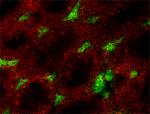
C57BL/6 mouse frozen testis section was fixed with 4% parafo... -
Alexa Fluor® 488 anti-mouse Galectin-9
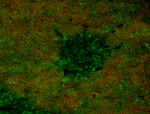
C57BL/6 mouse frozen thymus section was fixed with 4% parafo... -
PE/Cyanine7 anti-mouse Galectin-9
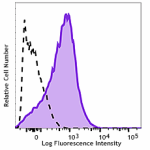
C57BL/6 mouse thymocytes were stained with anti-mouse Galect... -
APC anti-mouse Galectin-9
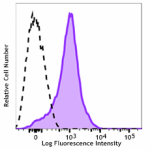
C57BL/6 mouse thymocytes were stained with anti-mouse Galect... -
Alexa Fluor® 647 anti-mouse Galectin-9

C57BL/6 mouse frozen thymus section was fixed with 4% parafo...
